Wound Trauma Exacerbates Acute, but not Delayed, Effects of Radiation in Rats: Mitigation by Lisinopril
Abstract
:1. Introduction
2. Results
2.1. Combined Injury Exacerbates ARS
2.2. Radiation Delays Skin Wound Healing during ARS, Which Is Not Mitigated by Lisinopril
2.3. DEARE Is Not Altered by Combined Injury but Is Improved by Lisinopril
2.4. Lisinopril Mitigates Radiation Pneumonitis after Combined Injury—Analyses by Lung Function (Secondary Endpoint)
2.5. Lisinopril Mitigates Radiation Nephropathy after Combined Injury—Analyses of Kidney Function (Secondary Endpoint)
3. Discussion
4. Conclusions
5. Materials and Methods
5.1. Animal Care
5.2. Groups
5.3. Animals and Irradiation
5.4. Supportive Care and Treatment with Lisinopril
5.5. Wounding
5.6. Measurement of Skin Wounds
5.7. Measurement of Breathing Interval
5.8. Measurement of Blood Urea Nitrogen (BUN)
5.9. Statistical Analyses
5.9.1. Morbidity
5.9.2. Statistics for Functional, Secondary Endpoints
Author Contributions
Funding
Conflicts of Interest
References
- Fish, B.L.; MacVittie, T.J.; Szabo, A.; Moulder, J.E.; Medhora, M. WAG/RijCmcr rat models for injuries to multiple organs by single high dose ionizing radiation: Similarities to nonhuman primates (NHP). Int. J. Radiat. Biol. 2020, 96, 81–92. [Google Scholar] [CrossRef] [PubMed]
- Moulder, J.E. 2013 Dade, W. Moeller lecture: Medical countermeasures against radiological terrorism. Health Phys. 2014, 107, 164–171. [Google Scholar] [CrossRef] [PubMed]
- Boerma, M.; Sridharan, V.; Mao, X.W.; Nelson, G.A.; Cheema, A.K.; Koturbash, I.; Singh, S.P.; Tackett, A.J.; Hauer-Jensen, M. Effects of ionizing radiation on the heart. Mutat. Res. 2016, 770, 319–327. [Google Scholar] [CrossRef] [PubMed] [Green Version]
- Ran, X.Z.; Shi, C.M.; Zheng, H.E.; Su, Y.P.; Cheng, T.M. Experimental research on the management of combined radiation-burn injury in China. Radiat. Res. 2011, 175, 382–389. [Google Scholar] [CrossRef]
- Kiang, J.G.; Zhai, M.; Bolduc, D.L.; Smith, J.T.; Anderson, M.N.; Ho, C.; Lin, B.; Jiang, S. Combined therapy of pegylated G-CSF and alxn4100TPO improves survival and mitigates acute radiation syndrome after whole-body ionizing irradiation alone and followed by wound trauma. Radiat. Res. 2017, 188, 476–490. [Google Scholar] [CrossRef] [Green Version]
- Manning, C.M.; Johnston, C.J.; Hernady, E.; Miller, J.N.; Reed, C.K.; Lawrence, B.P.; Williams, J.P.; Finkelstein, J.N. Exacerbation of lung radiation injury by viral infection: The role of Clara cells and Clara cell secretory protein. Radiat. Res. 2013, 179, 617–629. [Google Scholar] [CrossRef] [Green Version]
- DiCarlo, A.L.; Hatchett, R.J.; Kaminski, J.M.; Ledney, G.D.; Pellmar, T.C.; Okunieff, P.; Ramakrishnan, N. Medical countermeasures for radiation combined injury: Radiation with burn, blast, trauma and/or sepsis. report of an NIAID Workshop, March 26–27, 2007. Radiat. Res. 2008, 169, 712–721. [Google Scholar] [CrossRef]
- DiCarlo, A.L.; Ramakrishnan, N.; Hatchett, R.J. Radiation combined injury: Overview of NIAID research. Health Phys. 2010, 98, 863–867. [Google Scholar] [CrossRef]
- Ledney, G.D.; Stewart, D.A.; Exum, E.D.; Sheehy, P.A. Skin wound-enhanced survival and myelocytopoiesis in mice after whole-body irradiation. Acta Radiol. Oncol. 1981, 20, 29–38. [Google Scholar] [CrossRef] [Green Version]
- Ledney, G.D.; Exum, E.D.; Jackson, W.E., 3rd. Wound-induced alterations in survival of 60Co irradiated mice: Importance of wound timing. Experientia 1985, 41, 614–616. [Google Scholar] [CrossRef]
- Ledney, G.D.; Stewart, D.A.; Gruber, D.F.; Gelston, H.M., Jr.; Exum, E.D.; Sheehy, P.A. Hematopoietic colony-forming cells from mice after wound trauma. J. Surg. Res. 1985, 38, 55–65. [Google Scholar] [CrossRef]
- Gao, F.; Fish, B.L.; Szabo, A.; Schock, A.; Narayanan, J.; Jacobs, E.R.; Moulder, J.E.; Lazarova, Z.; Medhora, M. Enhanced survival from radiation pneumonitis by combined irradiation to the skin. Int. J. Radiat. Biol. 2014, 90, 753–761. [Google Scholar] [CrossRef] [PubMed] [Green Version]
- Garrett, J.; Orschell, C.M.; Mendonca, M.S.; Bigsby, R.M.; Dynlacht, J.R. Subcutaneous wounding postirradiation reduces radiation lethality in mice. Radiat. Res. 2014, 181, 578–583. [Google Scholar] [CrossRef] [PubMed]
- Dynlacht, J.R.; Garrett, J.; Joel, R.; Lane, K.; Mendonca, M.S.; Orschell, C.M. Further Characterization of the Mitigation of Radiation Lethality by Protective Wounding. Radiat. Res. 2017, 187, 732–742. [Google Scholar] [CrossRef]
- Fish, B.L.; Gao, F.; Narayanan, J.; Bergom, C.; Jacobs, E.R.; Cohen, E.P.; Moulder, J.E.; Orschell, C.M.; Medhora, M. Combined hydration and antibiotics with lisinopril to mitigate acute and delayed high-dose radiation injuries to multiple organs. Health Phys. 2016, 111, 410–419. [Google Scholar] [CrossRef] [Green Version]
- Travis, E.L.; Down, J.D.; Hall, L.; Vojnovic, B.; Holmes, S.J. Factors affecting the breathing rate of mice as used for studies of radiation damage to lungs. Br. J. Radiol. 1981, 54, 50–53. [Google Scholar] [CrossRef]
- Calveley, V.L.; Jelveh, S.; Langan, A.; Mahmood, J.; Yeung, I.W.; Van Dyk, J.; Hill, R.P. Genistein can mitigate the effect of radiation on rat lung tissue. Radiat. Res. 2010, 173, 602–611. [Google Scholar] [CrossRef] [Green Version]
- Medhora, M.; Gao, F.; Fish, B.L.; Jacobs, E.R.; Moulder, J.E.; Szabo, A. Dose-modifying factor for captopril for mitigation of radiation injury to normal lung. J. Radiat. Res. 2012, 53, 633–640. [Google Scholar] [CrossRef] [Green Version]
- Cohen, E.P.; Molteni, A.; Hill, P.; Fish, B.L.; Ward, W.F.; Moulder, J.E.; Carone, F.A. Captopril preserves function and ultrastructure in experimental radiation nephropathy. Lab. Investig. 1996, 75, 349–360. [Google Scholar]
- Moulder, J.E.; Fish, B.L.; Cohen, E.P.; Klein, J.P. Re: Davis et al. “Timing of captopril administration determines radiation protection or radiation sensitization in a murine model of total body irradiation”. Exp. Hematol. 2011, 39, 521–522. [Google Scholar] [CrossRef]
- Davis, T.A.; Landauer, M.R.; Mog, S.R.; Barshishat-Kupper, M.; Zins, S.R.; Amare, M.F.; Day, R.M. Timing of captopril administration determines radiation protection or radiation sensitization in a murine model of total body irradiation. Exp. Hematol. 2010, 38, 270–281. [Google Scholar] [CrossRef] [PubMed] [Green Version]
- McCart, E.A.; Lee, Y.H.; Jha, J.; Mungunsukh, O.; Rittase, W.B.; Summers, T.A., Jr.; Muir, J.; Day, R.M. Delayed captopril administration mitigates hematopoietic injury in a murine model of total body irradiation. Sci. Rep. 2019, 9, 2198. [Google Scholar] [CrossRef] [PubMed] [Green Version]
- Kiang, J.G.; Anderson, M.N.; Smith, J.T. Ghrelin therapy mitigates bone marrow injury and splenocytopenia by sustaining circulating G-CSF and KC increases after irradiation combined with wound. Cell. Biosci. 2018, 8, 27. [Google Scholar] [CrossRef] [PubMed]
- Jourdan, M.M.; Lopez, A.; Olasz, E.B.; Duncan, N.E.; Demara, M.; Kittipongdaja, W.; Fish, B.L.; Mader, M.; Schock, A.; Morrow, N.V.; et al. Laminin 332 deposition is diminished in irradiated skin in an animal model of combined radiation and wound skin injury. Radiat. Res. 2011, 176, 636–648. [Google Scholar] [CrossRef] [PubMed] [Green Version]
- Gao, F.; Fish, B.L.; Szabo, A.; Doctrow, S.R.; Kma, L.; Molthen, R.C.; Moulder, J.E.; Jacobs, E.R.; Medhora, M. Short-term treatment with a SOD/catalase mimetic, EUK-207, mitigates pneumonitis and fibrosis after single-dose total-body or whole-thoracic irradiation. Radiat. Res. 2012, 178, 468–480. [Google Scholar] [CrossRef]
- Kiang, J.G.; Jiao, W.; Cary, L.H.; Mog, S.R.; Elliott, T.B.; Pellmar, T.C.; Ledney, G.D. Wound trauma increases radiation-induced mortality by activation of iNOS pathway and elevation of cytokine concentrations and bacterial infection. Radiat. Res. 2010, 173, 319–332. [Google Scholar] [CrossRef]
- Kiang, J.G.; Ledney, G.D. Skin injuries reduce survival and modulate corticosterone, C-reactive protein, complement component 3, IgM, and prostaglandin E 2 after whole-body reactor-produced mixed field (n + gamma-photons) irradiation. Oxid. Med. Cell Longev. 2013, 2013, 821541. [Google Scholar]
- Swift, J.M.; Swift, S.N.; Smith, J.T.; Kiang, J.G.; Allen, M.R. Skin wound trauma, following high-dose radiation exposure, amplifies and prolongs skeletal tissue loss. Bone 2015, 81, 487–494. [Google Scholar] [CrossRef]
- Carter, S.R.; Zahs, A.; Palmer, J.L.; Wang, L.; Ramirez, L.; Gamelli, R.L.; Kovacs, E.J. Intestinal barrier disruption as a cause of mortality in combined radiation and burn injury. Shock 2013, 40, 281–289. [Google Scholar] [CrossRef] [Green Version]
- Carter, S.R.; Chen, M.M.; Palmer, J.L.; Wang, L.; Ramirez, L.; Plackett, T.P.; Gamelli, R.L.; Kovacs, E.J. Neutrophil accumulation in the small intestine contributes to local tissue destruction following combined radiation and burn Injury. J. Burn. Care Res. 2016, 37, 97–105. [Google Scholar] [CrossRef] [Green Version]
- Doctrow, S.R.; Lopez, A.; Schock, A.M.; Duncan, N.E.; Jourdan, M.M.; Olasz, E.B.; Moulder, J.E.; Fish, B.L.; Mader, M.; Lazar, J.; et al. A synthetic superoxide dismutase/catalase mimetic EUK-207 mitigates radiation dermatitis and promotes wound healing in irradiated rat skin. J. Investig. Dermatol. 2013, 133, 1088–1096. [Google Scholar] [CrossRef] [PubMed] [Green Version]
- Narendran, N.; Luzhna, L.; Kovalchuk, O. Sex difference of radiation response in occupational and accidental exposure. Front. Genet. 2019, 10, 260. [Google Scholar] [CrossRef] [PubMed]
- Medhora, M.; Gao, F.; Gasperetti, T.; Narayanan, J.; Khan, A.H.; Jacobs, E.R.; Fish, B.L. Delayed effects of acute radiation exposure (deare) in juvenile and old Rats: Mitigation by Lisinopril. Health Phys. 2019, 116, 529–545. [Google Scholar] [CrossRef]
- Conklin, J.J.; Walker, R.I.; Hirsch, E.F. Current concepts in the management of radiation injuries and associated trauma. Surg. Gynecol. Obstet. 1983, 156, 809–829. [Google Scholar] [PubMed]
- Medhora, M.; Gao, F.; Wu, Q.; Molthen, R.C.; Jacobs, E.R.; Moulder, J.E.; Fish, B.L. Model development and use of ACE inhibitors for preclinical mitigation of radiation-induced injury to multiple organs. Radiat. Res. 2014, 182, 545–555. [Google Scholar] [CrossRef] [Green Version]
- Moulder, J.E.; Cohen, E.P.; Fish, B.L. Captopril and losartan for mitigation of renal injury caused by single-dose total-body irradiation. Radiat. Res. 2011, 175, 29–36. [Google Scholar] [CrossRef] [Green Version]
- Cohen, E.P.; Moulder, J.E.; Fish, B.L.; Hill, P. Prophylaxis of experimental bone marrow transplant nephropathy. J. Lab. Clin. Med. 1994, 124, 371–380. [Google Scholar]
- Moulder, J.E.; Fish, B.L.; Cohen, E.P. Treatment of radiation nephropathy with ACE inhibitors. Int. J. Radiat. Oncol. Biol. Phys. 1993, 27, 93–99. [Google Scholar] [CrossRef]
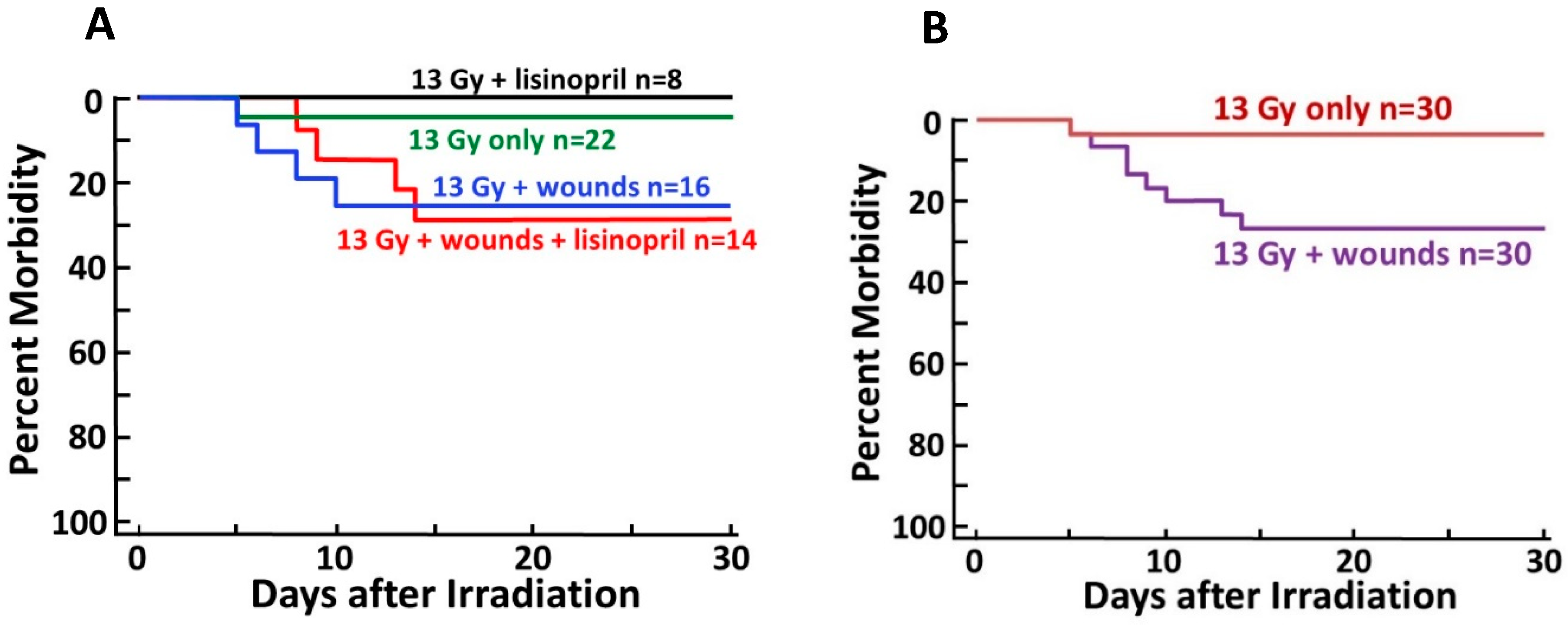
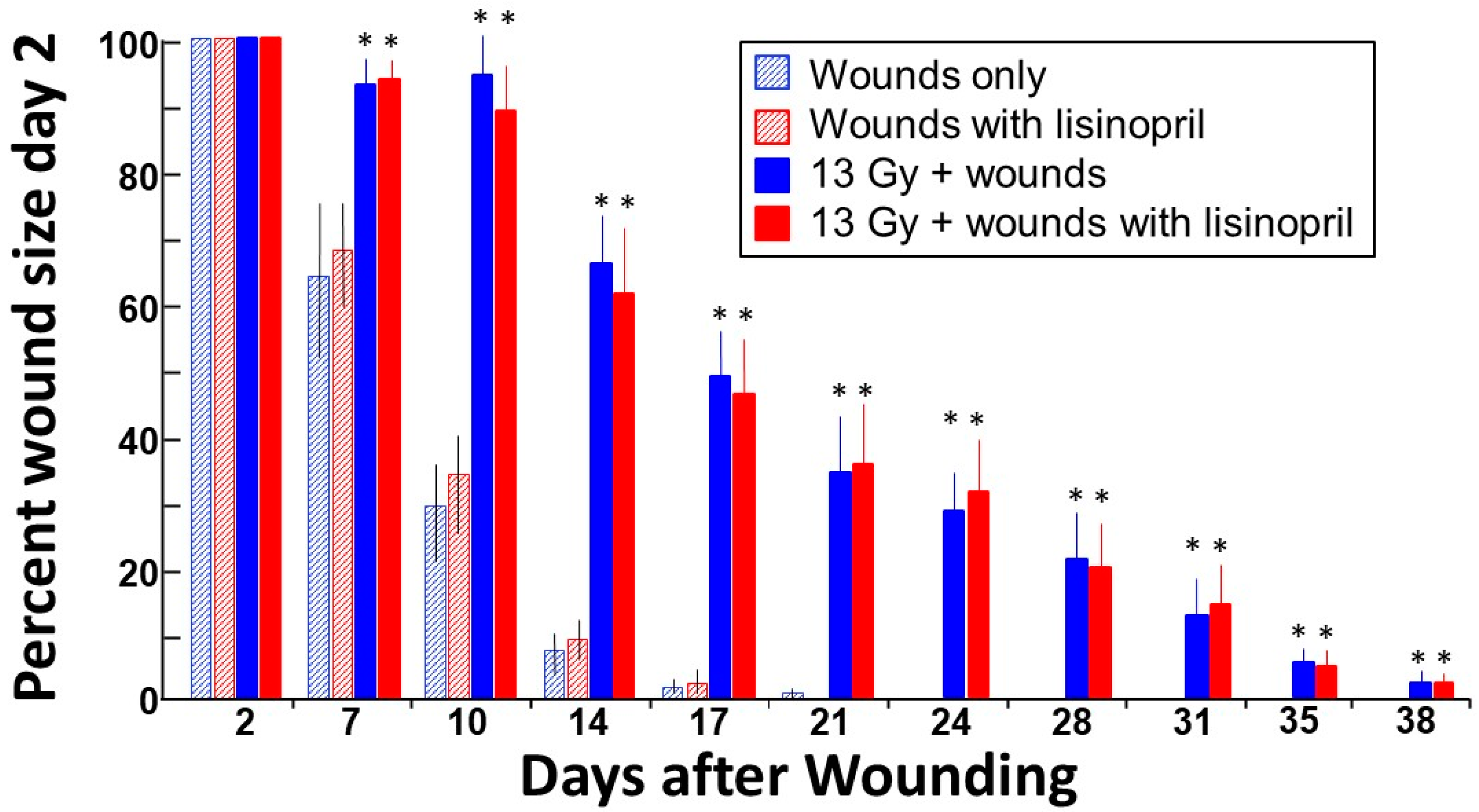

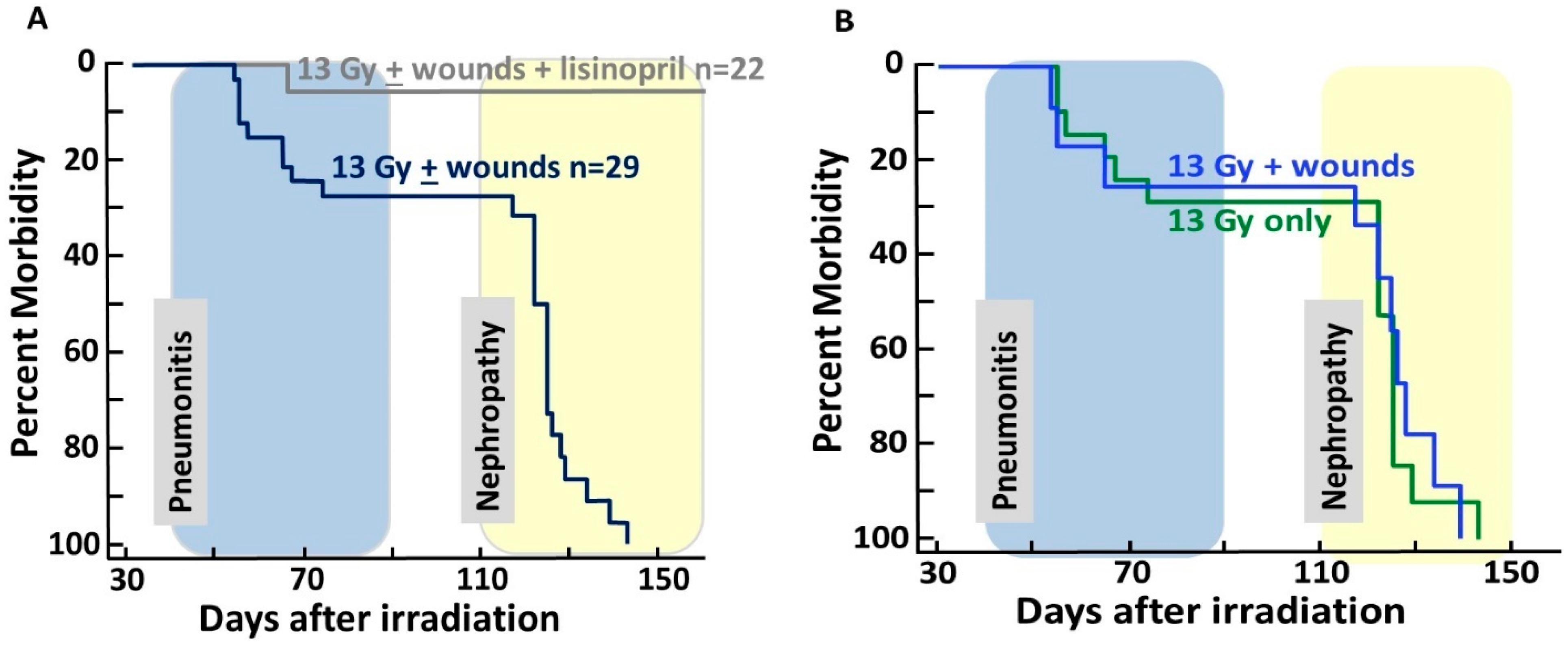
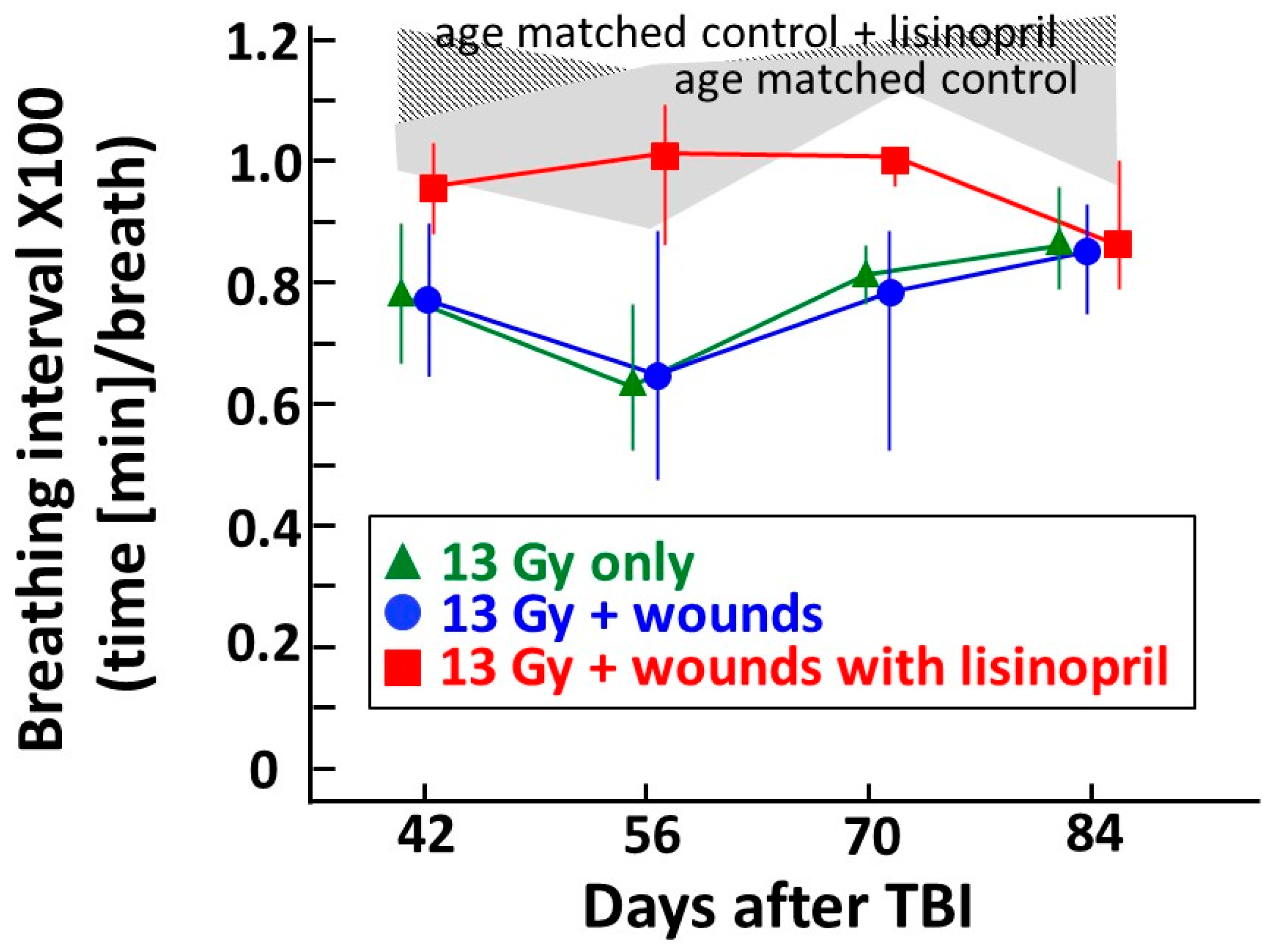
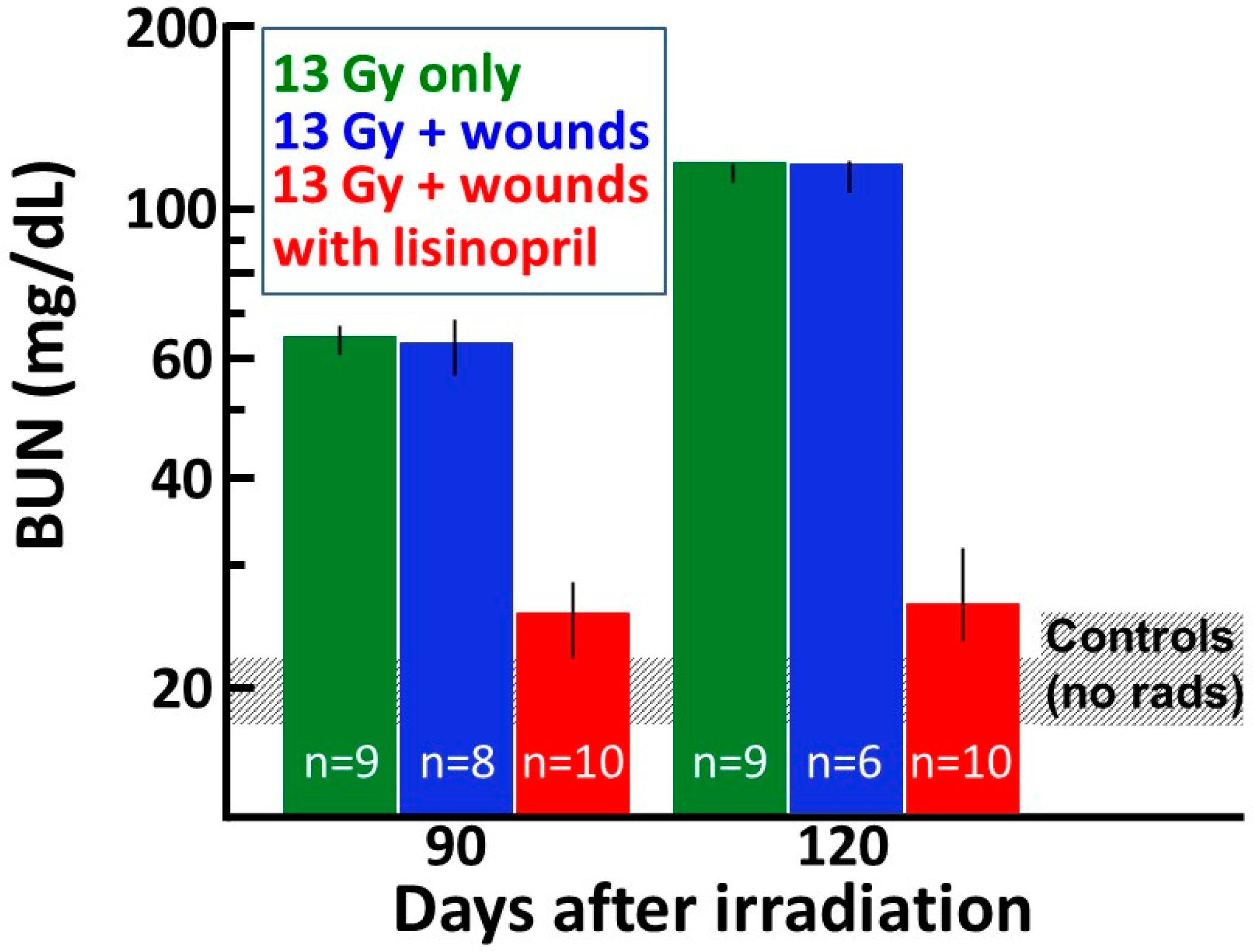
© 2020 by the authors. Licensee MDPI, Basel, Switzerland. This article is an open access article distributed under the terms and conditions of the Creative Commons Attribution (CC BY) license (http://creativecommons.org/licenses/by/4.0/).
Share and Cite
Medhora, M.; Gasperetti, T.; Schamerhorn, A.; Gao, F.; Narayanan, J.; Lazarova, Z.; Jacobs, E.R.; Tarima, S.; Fish, B.L. Wound Trauma Exacerbates Acute, but not Delayed, Effects of Radiation in Rats: Mitigation by Lisinopril. Int. J. Mol. Sci. 2020, 21, 3908. https://doi.org/10.3390/ijms21113908
Medhora M, Gasperetti T, Schamerhorn A, Gao F, Narayanan J, Lazarova Z, Jacobs ER, Tarima S, Fish BL. Wound Trauma Exacerbates Acute, but not Delayed, Effects of Radiation in Rats: Mitigation by Lisinopril. International Journal of Molecular Sciences. 2020; 21(11):3908. https://doi.org/10.3390/ijms21113908
Chicago/Turabian StyleMedhora, Meetha, Tracy Gasperetti, Ashley Schamerhorn, Feng Gao, Jayashree Narayanan, Zelmira Lazarova, Elizabeth R. Jacobs, Sergey Tarima, and Brian L. Fish. 2020. "Wound Trauma Exacerbates Acute, but not Delayed, Effects of Radiation in Rats: Mitigation by Lisinopril" International Journal of Molecular Sciences 21, no. 11: 3908. https://doi.org/10.3390/ijms21113908



